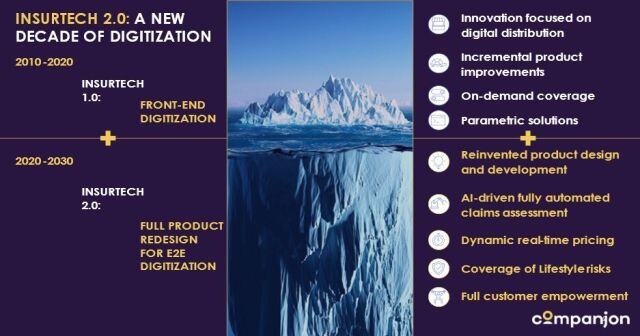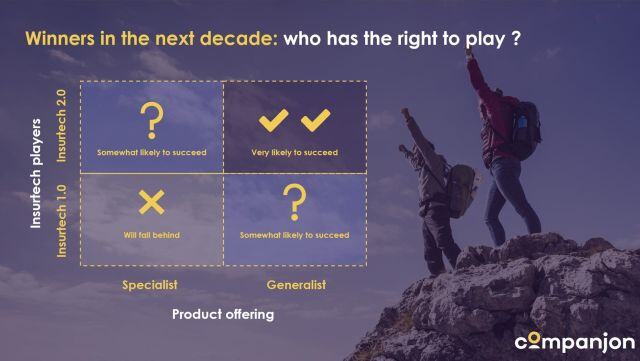
21 April 2021
Written By
By Matthias Naumann, Michael Vellat, and Aleksandar Totev
Insurtech 2.0: Insurance Reimagined
1. A New Decade of Disruption
During the last decade (2010 – 2020) we observed the rise of the first InsurTech players. Fuelled by incumbents’ hunt for additional distribution channels, most money was channeled towards innovating front-end capabilities and successfully digitizing distribution while existing products and processes remained the same. Considerable progress was made – today simple insurance products can be compared and bought online at the click of a button and digital access to more complex insurance products such as health and life insurance is becoming more widespread. The rise of parametric, on-demand and usage-based solutions in the last few years marks the pinnacle of this distribution-focused innovation and sets the stage for what is to come next.
The 20s will build on the previous decades’ success. InsurTech 2.0 unlocks the full potential of new products that are digitally native by design, allowing real end-to-end digital processing – instantly, for the first time (see Figure 1 “A new decade of digitisation”). Automated underwriting, pricing, claims, refunds, and even the format and content of the Terms and Conditions will become an integral part of the digital offering and will be essential to digital transformation success. The digitization of the entire value chain enables a completely different and intensively engaging digital experience that empowers the customer far beyond the mere purchase and comparison of an insurance product online.
Figure 1: “A new decade of digitisation”

2. A New Era of Unmatched Value for Customers
The rise of Big Tech as well as the sharing and gig economies have fundamentally changed customer expectations, also with respect to insurance. Customers are impatient and are constantly looking to maximise convenience and speed – one question too many during the underwriting process or one additional second for the website to load and the client may be lost. Consumers seek products, which satisfy an exact need during an exact period and are priced accordingly. Merely focusing on digital distribution will no longer be enough to succeed. InsurTech 2.0 will bring a new experience to insurance customers that is tailored to their needs and expectations, akin to the experiences customers are used to from other more tech-savvy industries outside insurance. The following 5 key benefits are essential for the digital native customers and will redefine how insurance is perceived.
The decisive power of add-on insurance – changing customer expectations in insurance [1]
- ~65% of consumers see automated and instant payout as a major advantage of InsurTech 2.0.
- More than half of the surveyed individuals would choose InsurTech products over traditional ones due to the very specific coverage they offer.
- Half of the consumers believe that traditional insurance is too expensive.
- 52% of consumers point to ease of purchase as a top differentiator of add-on digital insurance.
More value for money:
Consumers are increasingly price-sensitive and demand insurers to deliver value for money spent. Growingly, they analyse, compare, and evaluate propositions to justify cost efficiency and value. Especially the younger and tech-savvy generation seeks convenience, agility, and personalisation in their interaction with insurers. Modern car insurance products exemplify this trend: pay-per-km car insurance allows customers to pay for insurance based on the actual use they make of it; also, customers now allow insurers to monitor their driving behaviour in exchange for better premiums. Similarly, flight cancellation solutions will move from today’s fixed prices to live models that constantly adapt prices by factoring in variables such as “route”, “day of the week” and others. The technology to realise this is already available today.
"The rise of parametric products has enabled higher frequency and immediate claims pay outs based on a trigger event that does not require any customer involvement or submission"
Pricing is not the sole area InsurTech 2.0 delivers more value to customers. The rise of parametric products[2]has enabled higher frequency and immediate claims payouts based on a trigger event that does not require any customer involvement or submission. This essentially removes the most tedious customer-facing insurance process, replacing it with immediate and frequent compensation every time something does not go as planned. Digitisation of data gives InsurTechs access to larger, diversified, and more granular data pools that extend their capability to both create products with usage-based and dynamic pricing, as well as parametrise products to deliver instant claims payouts, ultimately delivering more value for customers’ money.
Real end-to-end digital experience:
Customers’ experience with insurance products will be reinvented. Claims experience provides the clearest example: manual and often paper-based processes designed to submit claims and collect claims-relevant data in an analogue setting will finally fulfill their promise of becoming fully digital, fast, even instant, and designed around the customer, not the process. This idea is not novel but will be complemented by a more radical shift: digitally native products will be designed to promote high-frequency claims events that customers want, finally allowing insurance companies to establish an ongoing and positive relationship with them. Recent research suggests that 63% of consumers view the ease of receiving automated and instant compensation as a compelling feature. The way insurance products and platforms are perceived and their role in customers’ everyday life will be changed for good.
Unmatched, flexible traditional and lifestyle coverage - on-demand and fully parametric:
Similar developments will be observed across the value chain: automated coverage triggers,[3]such as motor insurance automatically being activated once drivers start a cars’ engine, proactive communication focused on advice and prevention[4]and the ability to dynamically top-up policies with additional solutions will unlock the value truly end-to-end digitally native insurance products can deliver to customers. InsurTech 2.0 will leverage this constant interaction with customers to better and more deeply understand them. For example, a recent study uncovered that while roughly half of European consumers prefer cash compensation in case of a claims event, also vouchers, loyalty points, or in-kind compensation represent attractive options for customers[5]. Understanding and catering to such nuances across their customer base is key for insurance companies to deliver the better value-for-money solutions customers expect.
More positive experiences and more interactions with customers:
The insurance industry has notoriously struggled to keep customers engaged. After a policy was purchased, both customer and insurer had little reason to interact until a claim occurred. When it happened, the claims experience was complex and slow, justifying customers’ lack of loyalty toward insurance companies. InsurTech 2.0 will take a diametrically opposed approach, looking to drive up interactions by presenting customers with positive experiences. This is especially evident in a claim setting, where digitally native products will be designed for high claims frequency. Instead of avoiding the claim through complicated manual processes, InsurTech 2.0 will leverage gamified and fully automated claims processing to turn negative customer experiences into positive ones.
"Unlike before, the customer will be looking to engage with InsurTechs to benefit from services that help turn negative experiences into positive ones"
Put differently, claims will be initiated automatically without any customer intervention and in the vast majority of cases, be processed straight-through in a matter of seconds, thereby refunding the consumer instantly as the claim event unfolds. InsurTech 2.0 will capitalise on this increased interaction frequency by, for instance, leveraging artificial intelligence and bots to provide 24/7 support to customers across their preferred channels, allow customers to share their experiences with each other and notifying them if they are over-insured to suggest corrective actions. Unlike before, the customer will be looking to engage with InsurTechs to benefit from services that help him turn negative experiences into positive ones.
Empowering the user of mobility services
Mobility-as-a-service has become mainstream in developed markets and the number of people owning a car is gradually reducing. Meet Karl. Every time he needs a car, he uses the services of mobility providers. When Karl signs up, he receives an in-app notification asking whether he would like coverage for his rides. He opts in and the insurance premium is now part of the ride fare – easy and hassle-free. Whenever Karl reaches his destination, he gets off the car and moves on with his day, while the service fare is automatically withdrawn from his account only for the exact time during which he actually used the car.
One day Karl uses a car to go shopping. While reversing in the parking lot, he hits a stop sign and scratches the car. Karl quickly sends a photo of the damage to the insurer through the app. A couple of minutes later he is notified that the Artificial Intelligence-based claims system has assessed his claim successfully and gives him a choice between a monetary payout and a repair at a convenient service centre. He decides to go to the nearest repair shop and by the time he arrives, the insurer has already informed the mechanics of the damage, including the cost, and arranged a time slot for his car to be repaired.
Full customer empowerment and transparency:
Karl’s example might sound like science fiction, but this is the reality today for many simple P&C products. Their flexibility gives customers unprecedented choice and variety at every step of the customer journey. At purchase, they can choose from an all-encompassing insurance product that provides 360º coverage or decide to cover a single risk. Take the simple case of purchasing a concert ticket. The customer can decide to purchase cancellation, bad weather, and social distancing insurance in one package or opt for just one of the three.
When it is time to pay, the customer will not be offered credit card or bank transfer options only, but a wide variety of payment methods, including cryptocurrency. When something goes wrong and customers need to claim, they will be able to choose how they prefer to be compensated. Beyond the traditional monetary reimbursement, InsurTechs will offer vouchers or free subscriptions to other services as alternative forms of claims compensation.
3. The Fuel To Turbocharge Ecosystem Platforms
It is estimated that approximately 30%, namely more than USD 60 trillion of global revenue pools will be generated via ecosystems by 2025[6]. The above-mentioned data connectivity across technologies and sectors has enabled the relentless rise of ecosystems and platforms. Insurers’ ability to play an important role in existing and emerging ecosystems will be key to renewing the relevance of their business models.
Allow for real differentiation and attract additional new customers:
Successful platforms are able to fulfill a variety of related customer needs via one seamless customer experience. The insurance solutions that platforms deploy can make a meaningful difference in this space. Take a travel platform. Imagine booking a holiday to your favourite destination. You choose the hotel, arrange for flights, select the car you want to rent, and pre-book tables at the restaurants with the best reviews. At check out, you are offered cancellation insurance as an add-on.
"..it is not surprising that today almost three quarters of European consumers choose travel providers based on the cancellation options they offer. Choosing the right InsurTech 2.0 provider can prove to be a major catalyst"
You look through the Terms and Conditions to find that refunds are only granted in case of illness or bereavement of a close family member and under the condition of submitting a valid medical or death certificate. To save money you postpone the vacation from August to September, as the overall package is cheaper. Unfortunately, the insurance premium is the only element that remains unchanged. Finally, you recognise that the insurance provided for the car rental is different from the flight and hotel insurance, which means that in case of cancellation, you will face the complexity of dealing with two different providers.
Assume instead that at the moment of checkout, you are provided a list of insurance options that cover all of the elements within the package you are about to purchase. You can decide to cover the entire package or individually select specific elements, such as rental car insurance. You also notice that the cancellation coverage is much more extensive, and you can cancel at any time for any reason. If you do, the full amount of the trip is reimbursed automatically to your bank account without the need to submit any paperwork. Finally, your insurance premium is now cheaper in September compared to August.
Given the above, it is not surprising that today almost three-quarters of European consumers choose travel providers based on the cancellation options they offer[7]. Platforms operate in winner-take-all environments, where growth and new customer acquisition is king. Choosing the right InsurTech 2.0 provider can prove to be a major catalyst
Help drive conversion for platforms’ own products by giving customers the flexibility they expect:
InsurTech can help increase conversion rates for specific products, especially in times of major uncertainty. The introduction of add-on solutions such as flexible cancellation for any reason and quarantine cover may well make the difference between a customer deciding to buy or forgo a flight ticket, hotel stay, or even an entire holiday package. These features can easily be embedded and showcased into product marketing campaigns aimed at generating awareness, fuelling customer conversion, and establishing trust.
Deliver additional positive customer interaction and retention to drive satisfaction, brand awareness, and loyalty:
Large platforms today have different business units that serve customers across different needs spaces. For example, an entertainment company may own theme parks and cable networks. Promoting cross-selling across such different units can be difficult because the needs are disparate. InsurTech 2.0 can oftentimes provide the missing link, namely compensation. Imagine a family books a trip to their nearby theme park and buys insurance against bad weather.
"Overall, associating an experience with high frequency, repetitive claims and pay outs every time something goes wrong drives up customer satisfaction and encourages customers to return and switch to those platforms that offer it"
Unfortunately, three days before their scheduled trip, the insurance company notifies them that the weather forecast is looking bleak and gives them the option of a full ticket refund or a 3-month free subscription to one of the business’ cable networks. In this case, InsurTech 2.0 helped to do two things: firstly, it allowed the platform to leverage its other and seemingly unrelated offerings as compensation, thereby driving more customer traffic across the business; secondly, it took over the task of warning the customer of a potential negative future outcome and offering alternative solutions. Given that the future outcome is inevitably associated with the platforms’ brand, InsurTech 2.0 managed to turn a negative customer experience into a positive one, thereby actually reinforcing the brand and instilling loyalty. Overall, associating an experience with high frequency, repetitive claims, and payouts every time something goes wrong drives up customer satisfaction and encourages customers to return and switch to those platforms that offer it.
Manage the unforeseen by outsourcing the risk cover to InsurTech:
Embedding the above-mentioned solutions into the customer journey can be easy thanks to technology that today integrates seamlessly into any online platform. However, insurance remains a tightly regulated industry where licenses are required to distribute and underwrite insurance products and where underwriting, risk management & diversification, pricing, and policy wording require specific insurance expertise outside most platforms’ core competencies. Partnering with InsurTech lends platforms access to such competencies at essentially no cost and helps them avoid unpleasant surprises. The new generation of InsurTechs is well equipped to absorb the risks associated with these solutions, as they can spread them across more risk classes, industries, and geographies than any single platform can.
Access to additional, alternative, and fast-growing income that positively contributes to the bottom line:
While the positive impact on conversion rates described above helps grow platforms’ top line, the commission InsurTechs offer as compensation to their partners makes a direct positive contribution to their bottom line at little or no cost. This is especially true if partners minimise relationship management costs by selecting InsurTechs that represent a one-stop insurance shop that covers all of their customers’ needs, materially benefiting the entire ecosystem.
4. A New Set Of Capabilities For Success
According to BCG research, insurance today is still one of the least digitally mature industries globally, with most insurers underinvesting in digital initiatives[8]. This represents an unprecedented opportunity for new, digital, customer-centric, regulated and financially sustainable players to fill a space others are underinvesting in:
Proven ability to design parametric digital insurance products that are digitally native by nature:
As explained elsewhere, parametric insurance refers to a product that offers pre-specified pay-outs based upon a trigger event. This type of solution is key to introducing a fully automated no-human-touch claims experience. For example, take a flight delay compensation that pays out a predetermined monetary amount for every 30 minutes of delay. Flight delay data is made publicly available by third parties and can be easily integrated into an insurance product to trigger compensation on a customer’s bank account. In this case, the insurer no longer requires the customer to prove his right to claim, it already knows that a claim is owed and pays it out automatically.
The ability to develop parametric solutions becomes increasingly important to fulfill the promise of insurance products that are digitally native by nature. Accessing independent, reliable, and transparent third-party data to inform the trigger events, baking it into simple and easy-to-understand insurance products, ensuring that high-frequency payouts to customers work seamlessly, and reflecting these new dynamics in InsurTechs’ Terms and Conditions will be critical to success and require a cultural shift. Armies of claims specialists dedicated to assessing the veracity of claims and quantifying payouts will be redirected toward assessing that trigger events work seamlessly and to preventing data issues. Pricing will be adapted continuously, based on the flight data that is fed to the live pricing model. Finally, the simplicity of parametric products calls for a shift in the customer services set-up away from addressing complexity toward simpler and more standardised customer issues and queries, which allow for a high degree of standardisation and automation.
"The modularity of such tech engines will allow focused innovation across all parts of the value chain such as distribution, underwriting, pricing and claims, while still maintaining a coherent end-to-end process flow and ensure development cycles are reduced to a minimum"
Insurtech 2.0: Access to superior technology allowing for modular product stacks and fast development cycles:
Successful InsurTechs of the 20s will rely on superior core technology. This means application programming interface (API) that allows InsurTech 2.0 to easily and seamlessly integrate with platform partners. Such technologies can be built in-house, but the most successful ones will be sourced externally from World-class tech providers. They will allow InsurTechs to set up, launch, test, and scale highly modular solutions within a matter of weeks while providing the flexibility to pause or discontinue a product immediately in case it proves unsuccessful. The modularity of such tech engines will allow focused innovation across all parts of the value chain such as distribution, underwriting, pricing and claims, while still maintaining a coherent end-to-end process flow and ensuring development cycles are reduced to a minimum.
Broad portfolio of solutions across multiple Lines of Business with superfast implementation times:
Technology has increased the speed at which partnerships can be implemented. The negotiation of a partnership agreement and the relationship management aspects remain resource-intensive and costly efforts, however. Platforms and ecosystems have an incentive to minimize the number of partners they work with while at the same time maximising the seamlessness of the customer experience. InsurTechs must cater to this requirement and understand that platforms will not bear the cost of integrating many different providers, who are all individually the best at one parametric solution.
"Plug-and-play capabilities and short product development cycles will be critical to remain ahead of the competition"
This would be diametrically opposed to platforms’ mantra of fulfilling a variety of related customer needs via one seamless customer experience: imagine asking a customer to interact with different insurance solutions providers for different needs. This would reduce the seamlessness of the customer experience in addition to making relationship costs prohibitively expensive. It follows that 2.0 InsurTechs must own a broad offering that caters to all the insurance needs of a platform’s customers. Most importantly, that offering must be adaptable and responsive to platforms’ continuous changes in offerings and partnerships. Plug-and-play capabilities and short product development cycles will be critical to remaining ahead of the competition.
Financial stamina & carrier license(s) to stay ahead of the curve and ensure international rollout:
Technology alone is not enough to make the InsurTechs of the future successful. Having the culture and the financial stamina to innovate, fail fast, and learn in a strictly regulated environment will be essential for success. Start-ups often have a culture that drives them to try out new products but lack the resources to withstand material losses in the medium term. InsurTechs that can rely on a significant capital base backed by their shareholders are well-positioned for success, provided they are granted full operational freedom and independence.
Agile fast-moving teams of experts across several skill sets and levels of expertise:
Last, but not least, InsurTechs will have to be made up of young, agile and innovative teams that understand the technology and share a vision of the future of insurance, which is not rooted in its current state. For example, InsurTechs will not rely on traditional actuaries, but rather on data scientists that do however have a deep understanding of the strict regulatory requirements insurance companies must operate in.
5. Winners Of The Next Decade
Research suggests that digital maturity is a reliable predictor of performance across the insurance industry. The most digitally advanced players, of which InsurTechs are champions, outperform on Net Promoter Score (NPS) and Gross Written Premium (GWP) growth and operate at more competitive expense ratios, ultimately delivering better Total Shareholder Returns (TSR) compared to digital laggards[10]. This further underscores the critical role digital capabilities will play in the 20s, positioning the players that will dominate InsurTech 2.0 for success.
"...a few big winners will emerge to dominate the Insurtech 2.0 era,..namely companies who can offer a portfolio of comprehensive digitally native insurance on partnerships, leverage strict regulatory requirements to create safer and more valuable products, and have the financial stamina to play the long game"
This does not mean an automatic win for InsurTechs however, who will have to earn their right to play the hard way. Big ecosystem players and platforms are cautious toward new ventures, preferring to engage with the ones that have the financial stamina to become longer-term strategic partners. The larger and more established InsurTech 1.0 players that contributed meaningfully to innovating the distribution game in the 2010s and that are able to extend their digital capabilities beyond distribution to cover the entire value chain are likely to survive. On the other side, the classic InsurTech 1.0 players focused exclusively on the digital distribution of a handful of products will struggle.
Figure 2: “Winners In The Next Decade”

Ultimately, a few big winners will emerge to dominate the Insurtech 2.0 era, as exemplified in Figure 2 ‘Winners of the next decade” above, namely companies who can offer a portfolio of comprehensive digitally native insurance on partnerships, leverage strict regulatory requirements to create safer and more valuable products, and have the financial stamina to play the long game. On the traditional side, established players will continue partnering with InsurTech companies to top up their product suites, access additional distribution channels and expand their own capabilities. They will rely on large existing customer pools and strong capital positions to defend their industry dominance[10].
Authors

- Companjon pan-European consumer survey “The decisive power of add-on insurance”, Companjon (2021)
- Refers to an insurance product that offers pre-specified pay-outs based upon a trigger event e.g., flight delay compensation that pays out a predetermined monetary amount for every 30 minutes of delay
- 10 trends that will shape insurance in 2021, Accenture (2021)
- Parametric Insurance 2021 outlook and the companies to watch, InsTech London (2020)
- Companjon pan-European consumer survey “The decisive power of add-on insurance”, Companjon (2021)
- How do companies create value from digital ecosystems?, McKinsey (2020)
- Companjon pan-European consumer survey “The decisive power of add-on insurance”, Companjon (2021)
- Digital Underinvestment Hurts Insurers, BCG (2020)
- The 2020 Insurance Value Creators Report, BCG (2020)
- 10 trends that will shape insurance in 2021, Accenture (2021)
- Companjon Research Center, 2021. Companjon pan-European consumer survey “The decisive power of add-on insurance”. Companjon.
- Bender, T., Gielen, K., Schreiber, T., Schwemer, S. and Urban, M., 2020. Digital Underinvestment Hurts Insurers. BCG
- Corradi, D., Seidl, T. and Wick, E., 2020. The 2020 Insurance Value Creators Report. BCG.
- Dietz, M., Khan, H. and Rab, I., 2020. How do companies create value from digital ecosystems? McKinsey & Company.
- Gasc, J., 2021. 10 trends that will shape insurance in 2021. Accenture.
- Grant, M. and Kaur, P., 2020. Parametric Insurance 2021 outlook and the companies to watch. InsTech London.
Subscribe to updates
Get the latest insights and updates from Companjon.



